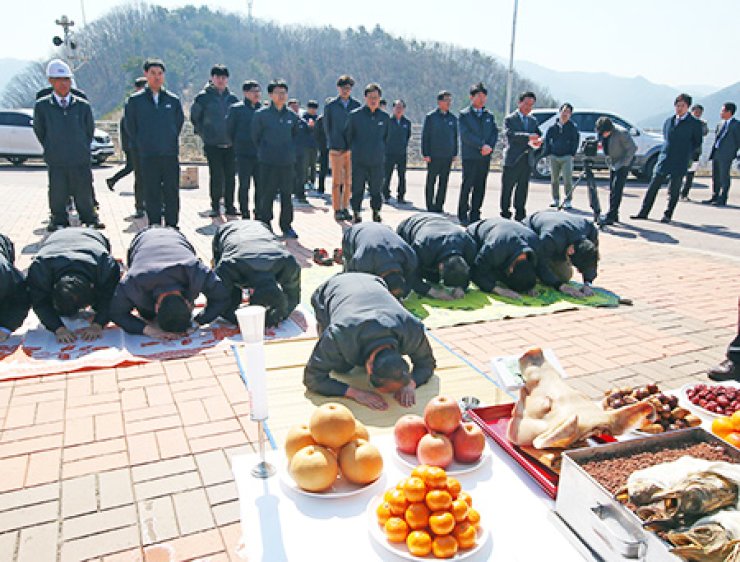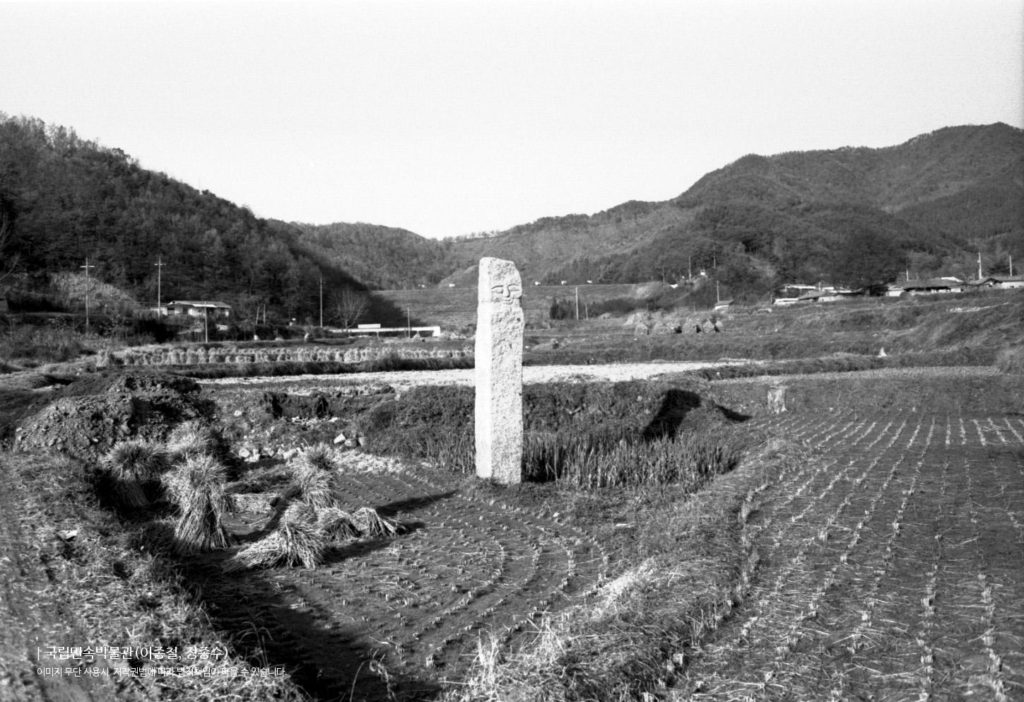Come Rain or Shine
Rituals of Traditional Korea
Original article by Shin Sang-soon.
Supplemented by David Shaffer.
For the agrarian economy of traditional Korea, rainfall during the growing season was critical: too much or too little could spell ruin for the harvest and severe hardship for the population. Rituals for rain as well as for not too much rain were conducted to appease the gods and placate the people. In our Blast from the Past article for this issue, we resurrect an article that originally appeared in our September 2006 issue of the Gwangju News, an article penned by Prof. Shin Sang-soon (1922–2011) as “A Ritual for Rain/Shine” and now supplemented here with additional material. — Ed.
Legend has it that in ancient China, Yu was made the son of the Heavenly King because he distinguished himself in governing the waters (chisu, 치수/治水). So, governing the mountains and rivers well was the most important job for the heavenly son, Cheonja (천자/天子) – that is, the ruler of the country. This age-old tale, indeed belief, permeated into early Korea, when agriculture was the sole means of production for the vast majority of the people, and fair weather was without a doubt the deciding factor for a good harvest. But natural phenomena are not always as fair as people wish them to be and are apt to be whimsical with prolonged rains or spells of drought. Faced with the people’s angst and anguish caused by the resulting natural disasters, rulers at every administrative level, from national or local, took responsibility for the severe weather conditions, blaming themselves for their own shortage of virtue.
Rain Rituals
When a nationwide spell of drought threatened his people, the Korean king himself presided over a ritual for rain. In cases of drought over local areas, the concerned local magistrate performed the task. An altar was set up on the top of a mountain and the magistrate ascended to the altar wearing rolled up trousers that exposed his calves. He raised his clasped hands in prayer to the Heavenly King, chanting an incantation for rain. Then, a hooded chastiser would appear with a cane and strike him on the calves until blood flowed from the wounds, symbolizing the removal of any ungodly character in addition to punishment for a weakness in virtue. Alternatively, regional magistrate would lash his own calves with a leather whip until blood was drawn.
The ritual could also be performed in the magistrate’s complex, in the Dong-heon (동헌, literally, “east building”), located in the direction of the sunrise. In the center of this office was the main pillar supporting the beam of the building. The pillar was called the “Heavenly Pillar” (cheonju, 천주), bearing a sacred function. That is, it was considered as the medium of communication between the Supreme Being in the heavens and the earthly governor of a locale. Therefore, it was customary for anyone passing the pillar to first bow to it; a magistrate made a bow to the pillar daily before commencing with his work.

As a somewhat similar rain ritual, when a region was suffering from a dry spell, the magistrate would take off his usual headpiece, kneel humbly before the pillar, and knock his head against the pillar until it bled. The bloodletting head-knocking signified finding a compassionate echo in the Heavenly King’s heart while the magistrate waited for his punishment for his lack of virtue or misgovernment.
When a drought was severe, causing immeasurable agony to the people, it was considered to be the Heavenly King’s punishment for an unjustifiable death or a mortifying death within the jurisdiction of the magistrate. A thorough investigation would be launched by the magistrate to uncover any grudge or complaint that may have been held against anyone recently deceased. For example, if there was a case of suicide by a chaste widow, the cause was thoroughly investigated: Had she possibly been raped, or had she killed herself to preserve family honor? Depending on the result of the investigation, the magistrate would hold a memorial service for the departed one to remedy the injustice incurred and set up a red memorial gate in her honor. Of course the culprits involved in the case would be apprehended and appropriately punished.
During the Joseon Dynasty period (1392–1910) state-organized rain rituals were categorized into a dozen hierarchically ranked types, including those mentioned above. On the upper end of the ranking were Confucian rituals held at the royal ancestral shrine of Jongmyo (종묘) in central Seoul, and at the lotus pond by Chundang-dae pavilion (춘당대) in Changgyeong Palace and at the pond surrounding Gyeonghoe-ru (경회루) in Gyeongbok Palace, both also located in central Seoul. This second type of rain ritual was held in natural settings where a Heavenly Dragon was believed to dwell, such as in forested areas and at bodies of water.

An interesting rain ritual participated in by children within the palace grounds was Seokcheok-dongja (석척동자, “lizard boy”). Wearing blue outer garments, the palace children would catch a lizard, symbolizing a dragon, and “torment” it by playing with it and exposing it to the scorching sun. The blue-clad children would chant, “Little Lizard, Little Lizard, give rise to white clouds, breathe out moist mist, make the rains pour down, and we will set you free” in the belief that this would induce the Heavenly Dragon to produce rain to save the parching lizard, and by consequence, give much needed relief from the drought.
The performance of rain rituals was not limited to royalty and government administrators. The common folk, the class most seriously affected by severe weather conditions, had their own rain rituals, some conducted by the menfolk, others by the womenfolk. It was often said that the women’s rituals were more effective than those of their male counterparts.
Village men would often hold rain rituals in hilltop areas, where it was common to find unmarked graves of secretly buried bodies, a common practice for the interment of those perishing before marriage. It was generally believed that death before marriage could cause the soul of the deceased to become restless and not properly pass over to the other world, and that improper burial could also cause misfortune for the living. These rituals would include digging up the corpse, building a large bonfire to produce lots of high-rising smoke, and offering supplications to the heavenly deities.
A common rainmaking ritual performed by village womenfolk was a bit risqué, which probably contributed to its lauded effectiveness. A large group of women would remove their undergarments, urinate on the ground, and then pour water from the village well on the already dampened area, apparently symbolizing rain falling on fertile soil to produce an ample harvest. Other rituals of village women were also steeped in symbolism. One of these was the pouring of water into a bamboo winnowing basket and sprinkling the water over the ground, obviously representing rainfall from a winnow-basket cloud above. Another was the wearing of bamboo rain hats while simulating the plowing of a field in the rain. A third was the flipping of a treadwheel upside down. While a treadwheel usually carried water up from an irrigation ditch to a rice paddy, a down-turned treadwheel represented rainfall.
Rituals for the Cessation of Rain
Until recent decades, Korean summers regularly consisted of a month-long rainy season (jangma-cheol, 장마철), roughly from mid-June to mid-July, followed by a month-long period of intense heat. This annual rainy season has been extremely important, particularly when Korea was mainly an agrarian society. Too little rain during the rainy season or too short of a rainy season could lead to drought, while exceedingly heavy rain and an extended rainy season could cause flooding and crop damage, resulting in a poor harvest if not complete decimation of the crops.
When the rainy season continued unabated until Ipchu (입추, the entrance of autumn; August 7 this year), this was an indication that the crops were in danger of ruin. In a ritual to stop the rains, the local magistrate would erect an altar on the designated mountaintop to proffer many offerings and supplications for the rains to end. For a ritual appealing for kingdom-wide stoppage of the inundation of rain, a high-ranking official would be sent to perform the rain-halting ritual for three days. If the rains did not stop, the ritual was repeated three times. The number “3” has long been considered an auspicious number in Korea.

Flood Prevention
Along with heavy and prolonged rains come not only crop damage but also flooding. As traditional Korea lacked dams and reservoirs, rivers overflowing their banks was a common occurrence, particularly in coastal regions and other low-lying areas. To protect against flooding, villages would erect flood-prevention steles of stone called sugumaegi (수구맥이; literally “water source blocker”) in an auspicious location facing in the direction from which flood waters might approach. These steles, and their associated deity by the same name, were believed to keep forceful water energy in check and to supplement geomantic energy when needed. Rituals such as susalmagi (수살막이) were also conducted at the village stele by the villagers as well as by farmers’ music troupes for the protection of the village against flooding caused by heavy rains and against related disease. Though much like wooden village guardian posts (jangseung, 장승) and prayer poles (sotdae, 솟대), which guarded against maladies and misfortune of all types, sugumaegi steles had the more specific function of preventing flooding.
Similar to sugumaegi steles in both form and function were stone stacks (doltap, 돌탑). These communally built structures of stacked stones could be conical, cylindrical, or hemispherical in shape, and an object was placed in the stone stack’s center, symbolizing the main purpose the stone stack was to serve: A rake or pitchfork would be placed inside for “raking” in good fortune, five types of grain for a good harvest, talismans to ward off evil spirits and misfortune, and a jar of salt to prevent flood damage. Much like talismans, salt was believed to possess the power to stave off evil and adversity.

The rituals described herein are those of a bygone era. However, that is not to say that they have vanished into antiquity. Though Korea’s system of dams and reservoirs has contributed greatly to flood prevention, drought still periodically presents a problem. While today some may offer prayers in their churches, one can still find newspaper articles of rain rituals being performed. Just two examples are the 2015 rain ritual in the Chuncheon area following a months-long drought, which was conducted by none other than Korea Water Resources Corporation officials, and also the 2017 rain ritual during an extended drought in Anseong, participated in by city officials and residents.
In modern Korea, ancient rain rituals live on: “Little Lizard, Little Lizard …”







